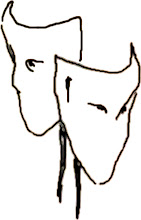Longtime Idle Muse fans who saw Bloody Poetry (2008) already know that we have an interest in the Romantic Poets. At the same time, I’ve also always been partial to Alfred Lord Tennyson. I’ve always seen him as something of a transition poet, straddling the divide between the Romantic and Victorian Era’s.
In the literary timeline I posted a few days ago, I dated Tennyson’s Idylls of the King in 1885, because that’s when the epic poem was completed. He actually began composing it in 1834, just prior to Victoria’s taking the throne. It was published over time in sections (idylls) and is considered by many to be something of an ongoing commentary on the era in which the poet lived.
The Victorians found in the myth of King Arthur an image of themselves. Throughout the period, there was a resurgence of Arthurian themes depicted in art and literature. The tale of the legendary British king’s emergence, rise and death provided a ready metaphor for the changing nature of their times – and they were indeed full of change.
Victoria’s reign oversaw the Industrial Revolution in England, and with it urbanization, overpopulation and widespread poverty. Simultaneously, this occurred at the height of the British Empire, a period called the Pax Britannica, during which British colonial interests and trade power were unmatched throughout the world. Meanwhile, science and technology were blossoming: gasworks and sanitation systems improved the quality of life in major cities, soap and antiseptics gained widespread use, and Charles Darwin’s Origin of Species rocked the world.
Underscoring all of this, a strict moral code sought to suppress the expression of emotion and rampant libertinism of previous ages – in a society that was becoming more and more deeply influenced by “oriental” ideas from abroad, even as it was reshaped by new technologies.
A side note: I love Wikipedia.
You can’t use it for academic purposes and you can’t blindly trust it – but if you already know a bit about a given subject, it can make for great conversation starters – not to mention dramturgical summaries in actor packets. For those looking to learn more about Victorian England, a couple of Wikipedia articles which, if not comprehensive or academically rigorous, make for good primers on the subject are:
Victorian Morality – short, condensed historical context
Victorian Era – longer and broader in focus
As for Tennyson, named Poet Laureate during this period, he addressed the fast-turning Victorian world in his Idylls through Bedivere’s lament, spoken as his king lay dying:
"Ah! my Lord Arthur, whither shall I go?
Where shall I hide my forehead and my eyes?
For now I see the true old times are dead,
When every morning brought a noble chance,
And every chance brought out a noble knight.
Such times have been not since the light that led
The holy Elders with the gift of myrrh.
But now the whole ROUND TABLE is dissolved
Which was an image of the mighty world;
And I, the last, go forth companionless,
And the days darken round me, and the years,
Among new men, strange faces, other minds."
Facing the harsh realities of the Industrial Revolution and looking back on the Romantic Era, it must have seemed to the Victorians that they might indeed be standing at the end of an ideal age. But Tennyson wanted to offer his readers one more thing…
Hope.
And slowly answer'd Arthur from the barge:
"The old order changeth, yielding place to new
And God fulfils Himself in many ways,
Lest one good custom should corrupt the world.
During the Victorian Era, people began looking at society analytically and believing it could be improved. There was a kind of faith that the acquisition and application of knowledge could better the individual and the world. This is the same era that gave birth to John Stuart Mill and Thomas Carlyle – and during which people were reading the ideas of Freud and Nietzsche. This is the era in England that gave birth to the idea of the self-made man, through which a burgeoning middle class won a place at the table among the aristocracy based on the strength of personal success.
This was the idea that an industrial, imperialist society, with all its inherent imperfections and injustices, could be better understood and was constantly evolving, on its way to something better:
Then from the dawn it seemed there came, but faint,
As from beyond the limit of the world,
Like the last echo born of a great cry,
Sounds, as if some fair city were one voice
Around a king returning from his wars.
Thereat once more he moved about, and clomb
Even to the highest he could climb, and saw,
Straining his eyes beneath an arch of hand,
Or thought he saw, the speck that bare the King,
Down that long water opening on the deep
Somewhere far off, pass on and on, and go
From less to less and vanish into light.
And the new sun rose bringing the new year.





Those looking to read up a bit more on Arthurian Legend in Victorian Art and Literature might be interested in a book called THE RETURN OF KING ARTHUR: THE LEGEND THROUGH VICTORIAN EYES, by Debra N. Madoff. It's a hardcover with beautiful illustrations, and available fairly inexpensively from Amazon.
ReplyDeleteAre we at the brink of another era or just a minor tidal swell?
ReplyDeleteInteresting to learn about the King Arthur story as a metaphor and, seriously -- 51 years?!?!? ;]
There's no shame with getting some of your background color from Wikipedia. Heck, most of us get our history from historical novels! The difference is you are reading those articles like you would an encyclopedia (encyclo-what?) and not using them for strict historical fact. I enjoy reading Wikipedia specifically for that purpose. It provides me with much additional color to enhance my reading.
ReplyDelete